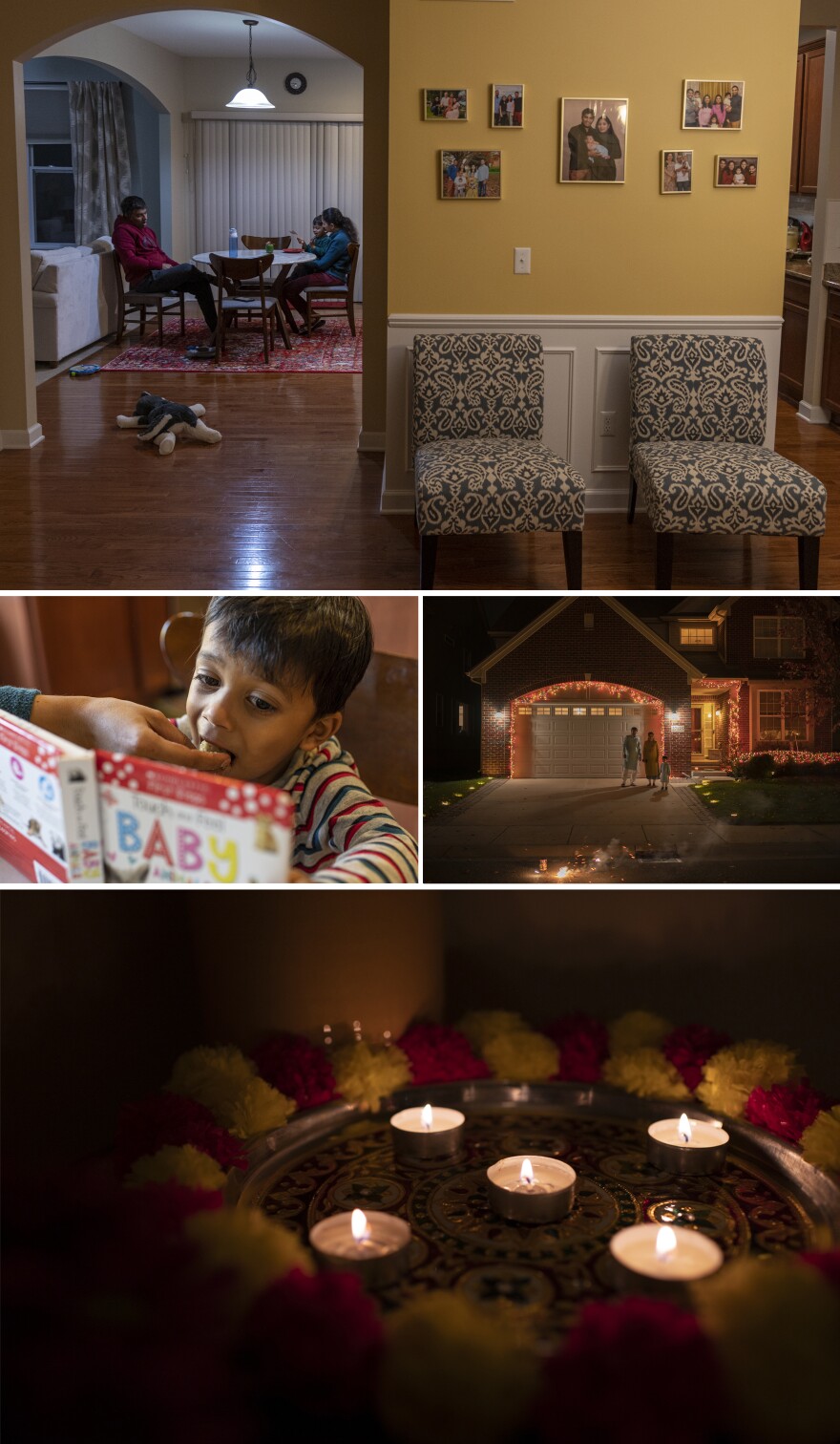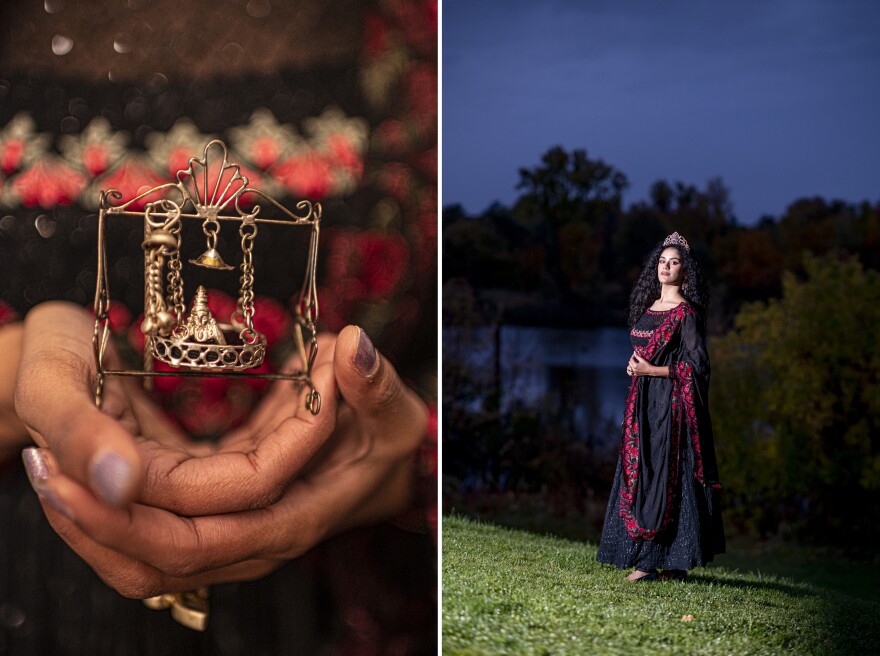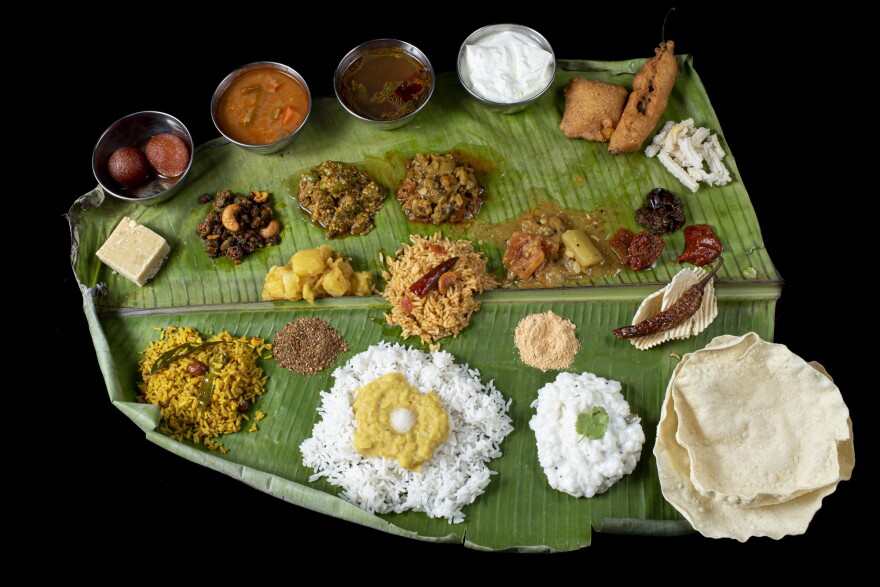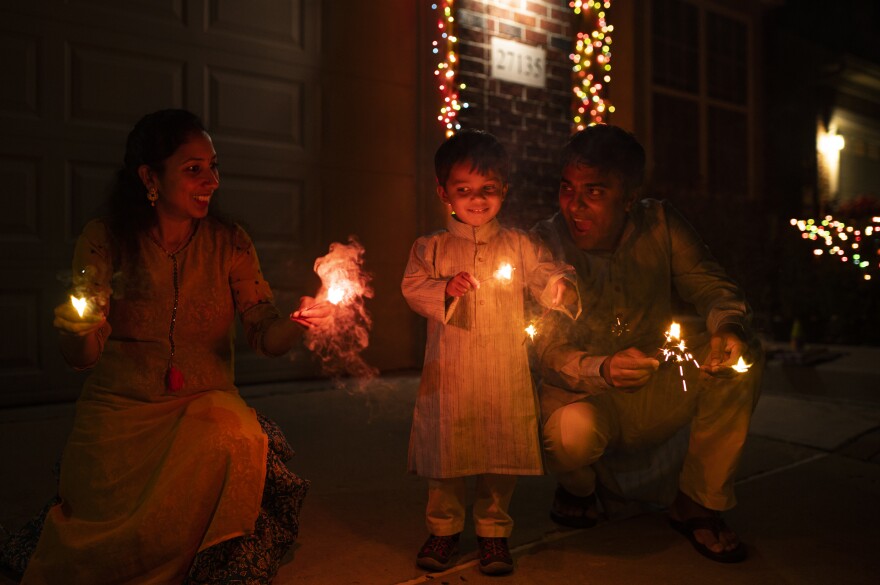Editor's note: May marks Asian Pacific American Heritage Month, which celebrates the histories of Americans hailing from across the Asian continent and from the Pacific islands of Melanesia, Micronesia and Polynesia. NPR's Picture Show will be bringing stories from these communities to our audience this month.
India is a land of diverse cultures and languages. Telugu Americans are a huge part of the Indian population living abroad. Telugu photographer Akash Pamarthy explores the Telugu community and identity in the United States through four lenses: family, keepsakes, festivals and food.
Telugu-speaking states Andhra Pradesh and Telangana in India account for 14% of all Indian Americans living in the United States. According to the Center for Immigration Studies, between 2010 and 2017, the number of native Telugu speakers in the U.S. surged 86% – the largest uptick in a foreign language-speaking group.
Family
Pavan Vemuri, 37, and Keerthi Sanivarapu, 35, moved to America from Telangana, India, for better opportunities and a quality of life called the "Indian American Dream." Both are engineers, worked through the immigration process, obtained work visas and bought a home together and currently raise their 2-year-old son, Ridhay Aaryan Vemuri, in Novi, Mich., with their Indian heritage.

"Our generation is, like, the only generation which is neither here nor there. We are the bridge between the kids and folks in India," Pavan says. "It is a lot tougher for us to balance upbringing with two cultures. If you take my family or her family, we are the last generation who can follow and pass our Indian culture to the next, and that is a huge burden and responsibility."
In Ridhay's family, he's exposed to the culture and traditions carried by his parents. Pavan and Keerthi make sure he understands traditions and respects his Telugu roots. They believe it's inevitable that Ridhay will pick up Western culture from school and other social environments, but that he can also learn the Indian way of things at home.


"We are so rooted to our culture, our things and do not want to change things," Pavan says. "We do not want him to totally go away from our culture and our roots, but (to) have a good balance.
"We make a conscious effort of talking to him in Telugu. Hopefully, it will last long," he continues. "Surprisingly, we don't have to put in a lot of effort to teach them a language, but must put in a lot of effort to continue to talk in that language."

Identity provides a narrative about oneself. Being a second-generation Telugu American is significant for some and, for others, it's a small part of how they conceptualize themselves. But a person's ethnic identity can be determined by their interactions with others of different racial backgrounds, their family and socioeconomic background.
"Raising a kid with dual identity, we are not the first people to come to the U.S. and experiment with it — many people have already done it, and it is our turn, right now, in our life," Keerthi says. "It is not easy. We are trying our best to see how successful we get at it."

Pieces of Home
Pamarthy also created a series of portraits capturing the stories of Telugu immigrants who moved to the United States to pursue education, work, marriage and more, all sharing in their pursuit of the American Dream. Many bring personal items or practices that remind them of home and to feel connected to their roots.

Sandhya Atmakuri moved to the U.S. in 1996 by marriage on dependent (H4) visa. She was not allowed to work under her visa status and wanted to go to law school, but that option wasn't financially viable. She received her green card in 2001 and started her dance school in 2002 after hearing from parents who were interested in teaching their kids how to dance to keep them culturally connected to their homeland. Through her school, the Natyadharmi Foundation of Performing Arts, she's been teaching Michigan children the classical Indian dance art forms of Kuchipudi and Bharatanatyam.

Vara Prasad Debbada was trained under Sri Jeera Swamy garu in Vijayawada, India, and was presented with prayer beads upon completing his training. He has held on to his beads since and uses them for chanting every day.
"Everyone wants to follow customs (and) religious practices but need guidance to do it the right way," he says, "and (it) makes me glad to be their spiritual guide."

Harini Sundar has always been interested in modeling — she was named Mrs. India Michigan in 2022 and went on to win third place in Mrs. India USA. When she moved from India, she brought a few personal items, but the closest to her heart is a Krishna idol with the swing.
"It is the most special thing in the house apart from my husband," she says. "The idol was given by my mom. I am a big devotee of Krishna — I consider to be his wife first then my husband's wife; he is the light in my life. The swing set belongs to my mother-in-law. She is no more, but I have known her since I was a kid and remember the great times I had with her. She is one of the main reasons I have married my husband. It is special to me to have something that was passed on to me by both my mothers — it is part of both families, a symbol of our unity and love."

Akhilesh Getti holds on to a recipe book presented by his mom when he moved here. "My mom is a good chef," he says. "She used to give crash courses for housewives who really want to learn Chinese cooking. My mom decided to make a note of all her dishes — all the preparations and whatever food I like. She knows it well and she made a note of all the recipes and gave me that book when I came to the U.S.
"Trying to live in an environment where you don't get good Indian food and is expensive, I used to refer to this book and get all the ingredients required to make this work," he continues. "My roommates and I would follow step-by-step procedures and make these recipes. It would still miss my mom's touch, but I developed cooking knowledge."
The Indian states of Telangana and Andhra Pradesh send the highest number of students to the U.S. every year. It has become a local tradition among middle- and upper-middle class families in both states to ensure that at least one person from the family goes to the U.S. to study or work.

Aparajitha Pamarthy's childhood dream has been to move to the U.S., secure a job and give her family a better standard of living, but she stayed in touch with her parents regularly, via phone. One day, she received an unexpected call about her father's critical health condition and was asked to fly home immediately. By the time she reached home, though, he had passed.
"I lost my dad five years ago and I have his jacket as his memory," she says. "I did not get a chance to talk to him during his last minutes. I talk to the frame to be in touch with him and let him know about my updates, as he has been my best friend since my childhood."
Festivals
Pamarthy focuses on rituals and festivals unique to the Telugu regions of India in his photography. He spent time with a community in Okemos, Mich., as they celebrated Bathukamma, a colorful floral festival of Telangana, one of the Telugu-speaking states. The festival is celebrated by women with exotic flowers from the region. Over the years, it's become a symbol of Telangana culture and identity and takes place annually, during the latter half of the monsoon season, before the onset of winter.
On a breezy October evening, women walk in through the doors of the Okemos High School in their colorful sarees and shiny Indian jewelry with beautiful pyramid-structured, layered stacks of flowers, which they call Bathukamma.
The women of the community place them together and sing songs while making rounds around them repeatedly in a circle of unity, love and sisterhood.

"Bathuku means life and Amma means goddess," Dr. Prashanti Mynampally, the president of the Greater Lansing Telangana Community, explains. "Bathukamma is life given by goddess."
For one whole week, they make small Bathukamma, play around them every evening and immerse them in a nearby pond. On the last day, the men of the house go into nearby fields and gather flowers like gunuka, or Celosia, and tangedu, or Senna auriculata. They bring home a bagful of flowers, and the entire household arranges them in stacks.

As dusk falls, after playing and dancing in circles, the women carry them on their heads and move in a procession toward a bigger water body near the village or town. Bathukamma is a celebration of the inherent relationship between human beings and earth and water.
The festival celebrates natural beauty, the camaraderie of the Telangana people, the tenacity of women and the ecological spirit of the agrarian people in protecting the environment in a festive way.
"We are proud, culture is maintained and passed on to the next generation," Dr. Mynampally says.
Food
Telugu cuisine is native to the Telugu people from the South Indian states of Andhra and Telangana and the region of Rayalaseema. Generally known for its tangy, hot and spicy taste, the foods are diverse due to the vast spread of the people and varied topological regions.

Andhra thali, or Bhojanam, in its most elaborate form, is a wholesome dish that's also a feast for your eyes, with its array of colors and bright bowls for each food. It's a quintessential eating experience in India, whether as part of a cultural tradition or everyday life.
Ragi flour is another staple rich in protein in the Rayalaseema region — one of the Telugu speaking states.
Telugu cuisine is usually smothered in masalas (spices such as cloves, cinnamon, cardamom, cumin, fenugreek seed), ginger/garlic paste and a generous quantity of chili powder or green chilies — the city and district of Guntur, in Andhra, is home to the biggest chili market in Asia.
Traditionally, Andhra food is served on a banana leaf to rows of people sitting cross-legged on the floor. At events, servers carry buckets of rice, sambar (lentil stew), dry vegetable preparation and chutney, serving everything on the leaf. The meal gets grander and richer if there's a celebration — especially for weddings, at which this form of serving and eating is popular.
The grain and lentil combination are considered to provide complete proteins necessary for survival, good health and immunity. An authentic Andhra thali or Bhojanam is an elaborate spread beginning with starters, the main course and ending on a sweet note with delicious dessert.
What it means to be Telugu in the United States
I personally feel the Indian community is one of the most underrepresented communities in media, despite being the second largest group of immigrants in the country. I never thought I would be working on stories from within the community, but I realized they're important and something that need to be told. Indian community is not just about the curry or vibrant colors; Indian community is so diverse in culture, language and food that we can't generalize it. I was exposed to lifestyles different from those of a Telugu person mainly because of the field I work in, but was fortunate to have friends and learn more about the community through them. That's how it sparked the enthusiasm to work on telling these submerged stories, which people experience and talk about but never have seen, visually. My aim is to travel around the United States and tell stories of the different sub-ethnic immigrant groups within the Indian community and learning their cultures myself.

Akash Pamarthy is a documentary photographer based in Athens, Ohio. He is currently an MFA candidate at Ohio University. His photography focuses on searching for answers to equality and humanity. See more of his work on his website, AkashPhotography.com, and on Instagram, @akashpamarthyphoto.
Maansi Srivastava photo edited this piece.
Zach Thompson copy edited this piece.
Grace Widyatmadja oversaw production of this piece.
Copyright 2023 NPR. To see more, visit https://www.npr.org.



